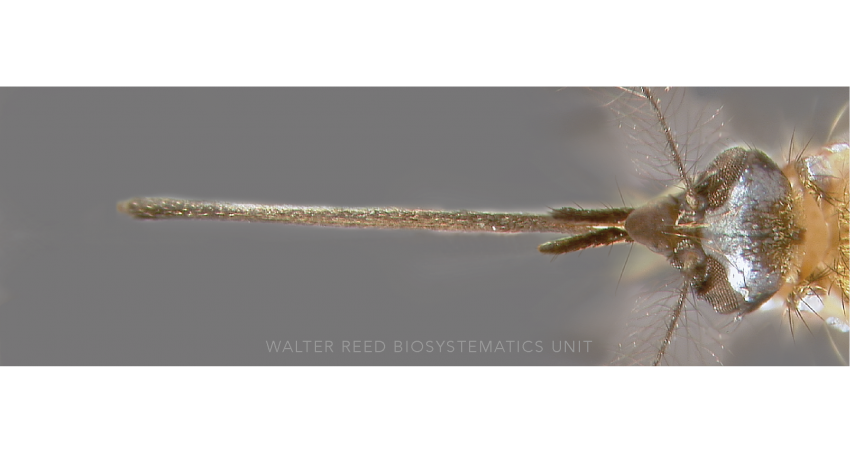AFROTROPICAL REGION
Generic abbreviation: Er.
Type species: Eretmapodites quinquevittatus Theobald 1901
Etymology: eretmon -oar & pod – footed (Gr); oar footed.
Eretmapodites adults are yellowish-brown, and bear a distinctive broad patch of flat silver scales that separating the eyes posterior to the antennae. ln all Eretmapodites species, the paratergite is bare and distinctly broad, a character that separates from all other African Aedines. The sylvatic genus Eretmapodites is unusual in that it is the only mosquito genus entirely restricted to Africa. The genus comprises 48 species, with no subgeneric groupings. Three species—Er. plioleucus Edwards, Er. silvestris Ingram & de Meillon, and Er. wansoni Edwards—comprise two subspecies. Eretmapodites quinquevittatus Theobald, originally described from specimens in Freetown, Sierra Leone, serves as the type species.
DIAGNOSTIC CHARACTERS (Click photos to view; mouse over and click large photo to zoom in.)
ADULT (illustrated): Head: Proboscis long, slender, and slightly downturned apically; interocular space and margins of eyes with broad, appressed, silvery scales. Thorax: Postspiracular setae present; paratergite very broad, without scales or setae. Abdomen: Terga black with silvery patches; abdominal segments laterally compressed, golden-yellow ventrally.
LARVA (not illustrated): Head: Antenna short and cylindrical. Abdomen: Setae 6-I–VI often borne on distinct projections. Terminal segments: Pecten with only 1–4 pecten spines; seta 4-X single or double, plumose, inserted on a small grid; comb scales in a patch.
TAXONOMIC KEYS
Edwards 1941
Haddow 1946
van Someren 1949b
Hopkins 1952
Hamon & van Someren 1961b
![]()
WRBU – Genera – Global – Larva
![]()
WRBU – Genera – Afrotropical – Adult
![]()
WRBU – Genera – Afrotropical – Larva
Exemplar DNA sequences
Er. intermedius COI: GQ165770, GQ165779, GQ165790
All Eretmapodites DNA sequences
BIONOMICS
Immatures
Eretmapodites immatures inhabit almost all natural containers on the forest floor, including fruit-husks, snail shells, fallen leaves, leaf spathes, split bamboo and even in small water collections in certain fungi species. They have also been recovered from water pools in discarded trash and in plant axils, e.g., Er. silvestris in Dracanena leaf axils in South Africa, and Er. conchobius in Sanseveira leaf axils in the Sudan. When resources are scarce, Eretmapodites larvae are secondarily predacious.
Adults
Eretmapodites species are commonly associated with African forests, and although preferred hosts include forest birds and mammals, some will feed on man. Female Er. conchobius are ierce and fearless biters, attacking man through their clothes in bright sunlight, some 20 meters out from the forest edge. In Uganda, Eretmapodites females are reportedy diurnal, biting at ground level in deep forest environments. Eretmapodites chrysogaster is a proven vector of yellow fever, and several other species have been implicated in the transmission of West Nile virus.
*Associated pathogens: This list reports bacteria, viruses, and parasites recovered from, or experimentally passed through this species, and does not imply field vector status.
IMPORTANT REFERENCES (full citations below)
Theobald, 1901d: ii (as genus)
Edwards 1912c: 46 (as Eretmopodites; unjustified emendment)
Brunetti 1914: 60 (designated type species)
Edwards 1941: 224, 403 (taxonomy adults, pupae, keys; Africa)
Haddow 1946: 57 (keys)
van Someren 1949b: 119 (key to males)
Hopkins 1952: 224 (taxonomy, bionomics, keys, larvae; Africa)
Hamon 1961: 892 (revision, oedipodeios ssp.)
Hamon & van Someren 1961b: 907 (key, Oedipodeios group)
Reinert 2001d (F genitalia*)
Reinert et al. 2004 (phylogeny, classification)
Reinert et al. 2009 (phylogeny, classification)
Wilkerson et al. 2015 (phylogeny, classification)
VALID SUBGENERA
None
CURRENT GENERIC SYNONYMS
None
CITED REFERENCES
Brunetti, E. (1914). Critical review of genera in Culicidae. Records of the Indian Museum, 10(2), 15–73.
Edwards, F.W. (1912c). A synopsis of the species of African Culicidae, other than Anopheles. Bulletin of Entomological Research, 3, 1–53.
Edwards, F.W. (1941). Mosquitoes of the Ethiopian Region. III. Culicine adults and pupae. Bulletin of the British Museum (Natural History) Entomology.
Haddow, A.J. (1946). The mosquitoes of Bwamba County, Uganda. IV—Studies on the genus Eretmapodites, Theobald. Bulletin of Entomological Research, 37(1), 57–82.
Hamon, J. (1961). Les Eretmapodites du groupe oedipodius Graham. 1. Descriptions complementaires et position systematique des six souse-espèces actuellement connues. Bulletin de la Société de pathologie exotique (Paris), 54, 892–906.
Hamon, J., & van Someren, E.C.C. (1961b). Les Eretmapodites du groupe Oedipodius Graham. II. Description de E. grenieri sp. n. et clé de determination des espèces et sous-espécies du groupe Oedipodius. Bulletin de la Société de pathologie exotique (Paris), 54, 907–913.
Hopkins, G.H.E. (1952). Mosquitoes of the Ethiopian region. I. Larval bionomics of mosquitoes and taxonomy of culicine larvae (2nd ed.). London, UK: British Museum (Natural History).
Reinert, J.F. (2001d). Comparative anatomy of the female genitalia of genera and subgenera in tribe Aedini (Diptera: Culicidae). Part IX. Genus Eretmapodites Theobald. Contributions of the American Entomological Institute, 32(4), 41–49.
Reinert, J.F., Harbach, R.E., & Kitching, I.J. (2004). Phylogeny and classification of Aedini (Diptera: Culicidae), based on morphological characters of all life stages. Zoological Journal of the Linnean Society, 142, 289–368.
Reinert, J.F., Harbach, R.E., & Kitching, I.J. (2009). Phylogeny and classification of tribe Aedini (Diptera: Culicidae). Zoological Journal of the Linnean Society, 157(4), 700–794.
Theobald, F.V. (1901d). Notes on a collection of mosquitoes from West Africa, and descriptions of new species. Liverpool School of Tropical Medicine Memoir, 4.
van Someren, E.C.C. (1949b). Ethiopian Culicidae - Eretmapodites Theobald: Description of four new species of the chrysogaster group with notes on the five known species of this group. Proceedings of the Royal Entomological Society (B), 18(7–8), 119–129.
Wilkerson, R.C., Linton, Y.-M., Fonseca, D., Schultz, T., Price, D., & Strickman, D. (2015). Making mosquito taxonomy useful: A stable classification of tribe Aedini that balances utility with current knowledge of evolutionary relationships. PLoS ONE, 10(7), e0133602.
CITE THIS PAGE
Walter Reed Biosystematics Unit (Year). Eretmapodites genus page. Walter Reed Biosystematics Unit Website, http://wrbu.si.edu/vectorspecies/genera/eretmapodites, accessed on [date (e.g. 03 February 2020) when you last viewed the site].






